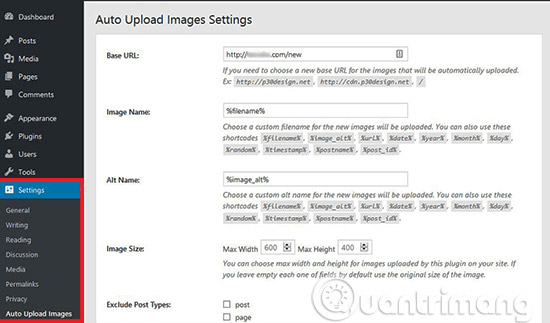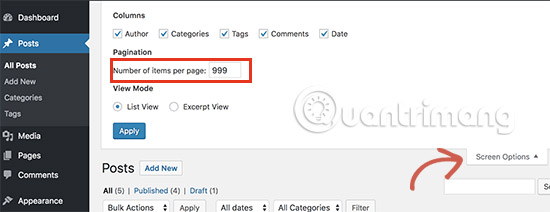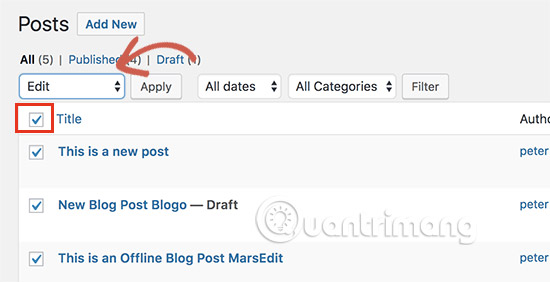How to import images from external sources into WordPress
Do you want to import an external image into WordPress? If you recently moved your site from platform to platform, it is very likely that you have an external image to embed on your pages. This article will explain how to correctly import those external images into WordPress.
How to import images from external sources into WordPress
- When and why do you need to import images from external sources?
- Video tutorial
- Enter the external image into WordPress
When and why do you need to import images from external sources?
External images are images embedded in web content, loaded from web pages or URLs other than the main website.
Typically, WordPress users experience external image problems after migrating their sites from other platforms such as Blogger, Weebly, Joomla or WordPress.com.

By default, if you use one of the WordPress importers, it is in charge of importing images. You can see if the image has been imported, by visiting the Media> Library page in the WordPress admin page.
If you find that all your images are already there, but the post URL links to the old source, then you don't need this article. Instead, you need to update the URLs using the Velvet Blues Update URL plugin.
However, if you don't see the image imported into the WordPress media library, continue reading for instructions on how to import images from that external source.
Video tutorial
If you do not want to watch the tutorial video, you can continue to read the detailed instructions below:
Enter the external image into WordPress
The first thing you need to do is install and activate the Auto Upload Images plugin.
When activated, you need to access the Settings> Auto Upload Images page to review the plugin settings.

The default settings will work for most users, but you can change them as needed.
The plugin will import the image into the default WordPress upload media folder. You can change that by providing another base URL. In addition, it also allows you to set the file name, alt image tag, image size and exclude post types.
When you're done, don't forget to click the Save Changes button to save the settings.
Next, you will need to update the articles or pages containing images from external sources. Since this is a manual process, it can be a bit tedious, if you have a lot of content to update.
Fortunately, there is a quick way to update all posts with images from external sources. Simply go to the Posts page > All Posts and then click the Screen Options button at the top.

You need to enter 999 in the ' Number of items per page field ' field and click the Apply button .
WordPress will reload the page and this time it will display 999 posts at once. Next, you need to select all your posts and then choose Edit in the Bulk actions menu.

Then you need to click the Apply button . WordPress will show you a quick edit box with all selected posts. You just need to click the Update button and WordPress will update all posts.
Remember, do not change any settings in the bulk editing settings you see. You just need to click Update.
This process will activate the plugin to check all selected posts and import images from external sources when they are found.
If you have more than 999 posts, you will need to visit the next page to select the remaining posts.
Hopefully this article has helped you understand how to import images from external sources into WordPress. Good luck!
See more:
- Why is WordPress free?
- How much does it cost to build a WordPress website?
- How to migrate blogs from WordPress.com to WordPress.org
You should read it
- 5 mistakes everyone mistakenly thinks about WordPress
- What's new in WordPress 5.4?
- How to update URLs when moving WordPress sites
- How to post photos and videos in WordPress
- How to add new posts on WordPress
- 20 WordPress plugins for photo websites (2018)
- 5 remarkable new plugins for WordPress
- Squarespace and WordPress - Which one is better?
May be interested
- How to migrate blogs from WordPress.com to WordPress.org
 today's article will show you how to migrate your existing wordpress.com blog to wordpress.org, how to keep search engine rankings for the site and how to redirect existing users.
today's article will show you how to migrate your existing wordpress.com blog to wordpress.org, how to keep search engine rankings for the site and how to redirect existing users. - Instructions for installing WordPress on the Vitual Server with Cloud9
 downloading and running internal wordpress servers is quite complicated. if you are a seasoned developer, you should set up a local server with xampp or wamp. but if you are a 'new' who just wants to 'mischief' install wordpress self-host, follow and follow the steps below.
downloading and running internal wordpress servers is quite complicated. if you are a seasoned developer, you should set up a local server with xampp or wamp. but if you are a 'new' who just wants to 'mischief' install wordpress self-host, follow and follow the steps below. - Wix and Wordpress - Which one is better?
 this article will compare wix with wordpress and highlight the pros and cons of each platform. hopefully after reviewing and comparing wix with wordpress, you will be able to decide which platform is right for you.
this article will compare wix with wordpress and highlight the pros and cons of each platform. hopefully after reviewing and comparing wix with wordpress, you will be able to decide which platform is right for you. - How much does it cost to build a WordPress website?
 although the core wordpress software is free, the cost of a wordpress site depends entirely on your budget and goals.
although the core wordpress software is free, the cost of a wordpress site depends entirely on your budget and goals. - How to change the font in WordPress
 once you have successfully installed and set up wordpress on localhost, you realize one thing: wordpress's default font when typing vietnamese does not look good, it is not beautiful when using large font size, or zoom in. .. or simply, we want to change the default font of wordpress, how to do it?
once you have successfully installed and set up wordpress on localhost, you realize one thing: wordpress's default font when typing vietnamese does not look good, it is not beautiful when using large font size, or zoom in. .. or simply, we want to change the default font of wordpress, how to do it? - How to install WordPress plugin
 after installing wordpress, the first thing that people need to start learning is how to install wordpress plugins. in this step-by-step guide, tipsmake.com will show you how to install a wordpress plugin.
after installing wordpress, the first thing that people need to start learning is how to install wordpress plugins. in this step-by-step guide, tipsmake.com will show you how to install a wordpress plugin. - Instructions for installing WordPress on Bluehost
 in this article, you will learn how to install wordpress on bluehost using different methods. the article will also mention what makes bluehost a unique hosting for wordpress.
in this article, you will learn how to install wordpress on bluehost using different methods. the article will also mention what makes bluehost a unique hosting for wordpress. - How to delete posts posted on WordPress
 posting on wordpress is very simple and it is easy to delete posts. we can control posts posted to wordpress and delete them if necessary.
posting on wordpress is very simple and it is easy to delete posts. we can control posts posted to wordpress and delete them if necessary. - Is Drupal or WordPress the best open source CMS?
 chances are, when you think about building websites, from wordpress almost immediately appears in your head. wordpress 'dominates' thanks to its market share and accessibility.
chances are, when you think about building websites, from wordpress almost immediately appears in your head. wordpress 'dominates' thanks to its market share and accessibility. - How to install applications from unknown sources on Android
 by default, installing applications from unknown sources on android is not allowed, but with the tips in the article below, you can comfortably install applications from external sources without problems.
by default, installing applications from unknown sources on android is not allowed, but with the tips in the article below, you can comfortably install applications from external sources without problems.










 Instructions for finding or creating an RSS feed for a website
Instructions for finding or creating an RSS feed for a website Instructions on how to embed Google Forms into WordPress
Instructions on how to embed Google Forms into WordPress Do you know how to prevent website theft?
Do you know how to prevent website theft? Don't ignore these 10 security tips when creating a new website
Don't ignore these 10 security tips when creating a new website